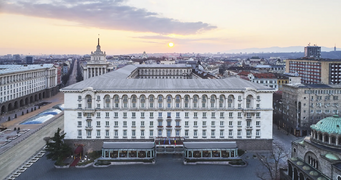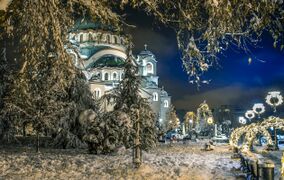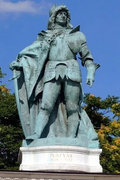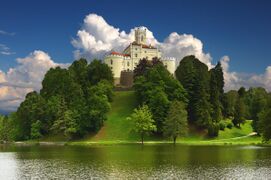Chrobonsk
This article is considered abandoned lore either because its creator has changed projects or has left the community. Accordingly, it is not only non-canon but it is also eligible for salvage pending approval from an administrator.
|
Chrobonsk ("The Most Holy and Serene Tsardom of Chrobonsk") Пресвето и Свето Царство Хробонско (Suratian) | |
|---|---|
Anthem: | |
| Capital | Belgrini |
| Largest city | Srimonsk |
| Official languages | Suratian Latin Greek |
| Ethnic groups | Suratians |
| Religion | Caphiric Catholocism |
| Demonym(s) | Chrobonskian (noun) Chrobonskian (adjective) |
| Government | Mixed Monarchy |
• Tsar | Flamur Milos Chrobonsk II |
| Legislature | Chrobonskian Parliament |
| Parliamentary Council | |
| Duma | |
| Establishment | |
• Royal Marriage of Dimitri Chrob and Maria Onsk | c. 1250 |
| Currency | Chleb (chb) |
| Driving side | right |
| Calling code | +75 |
| Internet TLD | .cb |
Chrobonsk, officially the Most Holy and Serene Tzardom of Chrobonsk, is a Mixed Monarchist Tzardom in southern Sarpedon. It is neighbored by Caphiria, Zeshinava, and Aciria. It has been historically linked to Caphiria since the Bronze Age, and continues to be a supporter of the nation.
In prehistoric times, Chrobonsk was inhabited by a diverse group of ethnically indigenous Sarpedonic tribes that were in one way or another eradicated by the ancient Suratian civilization. This civilization ended up collapsing due to what is speculated to be a mass famine. Out of the collapse of the original Suratian civilization, came the Suratian city states. These were largely mercantile peoples that gained their wealth from trading with Caphiria in antiquity.
The Suratian city states were made into a handful of tributary states under the first Caphiric Imperium, but the region broke out into over a hundred noble entities once the empire lost its administrative grasp. For over a hundred years these nobles were embroiled in a constant state of warfare, vying for power over one another. All with aims of uniting the region. This came to an end with the formation of the Tzardom itself when a royal marriage between the two most powerful noble houses combined the two to form a single kingdom with a ruling monarch. These were the houses Chrob and Onsk, respectively.
After the establishment of the monarchy Chrobonskian art and culture flourished, and the region become incredibly prosperous leading to the establishment of the University of Srimonsk. This age of stability set a precedent for the monarchy, and some historians speculate it is why it has survived for so long.
Despite its time as a holding of the Caphiric Empire, it is generally felt in Chrobonsk that this was an integral part of its transition into becoming a modern state. As such, Chrobonsk has supported Caphiric interest in every conflict Caphiria has been in. Chrobonsk is also fiercely supportive of Sarpedonic and Vallosian interests. As such, a majority of its manufactured arms is distributed exclusively to nations in Sarpedon.
Chrobonsk is a member of the League of Nations.
Etymology
Chrobonsk is portmanteaux formed from the wedding of the founding monarchs of the Kingdom - King Dimitri Chrob and Queen Maria Onsk.
History
Chrobonsk was for most of its history a land of loosely confederates counties and duchies surrounding the southern river inlet of Sarpedon embroiled constant political strife. The Tzardom itself was formed when a royal marriage was formed between the two most powerful houses of the region, forcing the less powerful noble entities in the region to bend the knee.
Bronze Age
The first settlements and city states were formed up and down the great river basin (placeholder name) that flows through the nation by the indigenous Sarpedonian tribes that we now ethnically know as the Suratii. While in the bronze age they were more than likely much more ethnically and culturally diverse to be lumped into one ethnic group, the Suratii eventually became more culturally and ethnically salient Though much is lost of these ancient cultures, it is known that their main source of income was trading wine and barley up and down the river.
Suratian Civilization
The disjointed kingdoms of the region rarely had any interactions at all with foreign powers, with the exception of the fledgling Caphirian Republic, whose trade allowed the early city states to flourish into actual political entities. The Suratii kingdoms were largely mercantile in nature and relied on the river for trade with one another. Though there are some records that indicate that at least a few wars were waged between the kingdoms. Most of what historians have from this period come from oral tradition that was later put into writing. Ruins of temples have also been excavated closer to the riverbanks, filled with large bathing pools - suggesting that the river was at one point the subject of worship.
The Suratian City States
After the collapse of the Suratian civilization, a majority of the surviving Suratians conglomerated into the major cities at th time. These developed into a handful of city states who vied against one another for regional power, sometimes coalescing against larger threats such as Caphiria.
although there is evidence of inter city state military conflicts happening, there is a larger amount of archaeological evidence to suggest that their rivalries were benign and reflected more in trade relationships with Caphiria or larger non Sarpedonic powers. Some of these cities exist to this day, the most famous being Belgrisi, known in antiquity as “Beksiksi”.
The War of a Hundred Kingdoms
What modern historians consider to be the beginning of Chrobonskian history would be the formation of the Breakaway Kingdoms. These were once nobles loyal to the Caphirian Empire who, in the midst of the chaos, decided to form their own kingdoms. Scholars estimate that as many as one hundred and fifty politically salient entities existed across the Chrobonskian provinces at this time. The largest conflict of this time period was known as the War of the Southern Coalition. Where a large group of nobles who feared House Chrob’s growing hegemony in the Northeastern region banded together to challenge its holdings. The war lasted ten years, and is the subject of the Chrobonskian novel “Steadfast Heart”.
The Wedding at the Mouth
Eventually, two quasi-coalitions formed on either side of the river (placeholder). One side ruled by House Chrob, the other by House Onsk. While historically bitter rivals, the two houses saw an opportunity to unite and form a state for all Suratii peoples. This period is considered to be the golden age of Chrobonskian history due to an increase in academic movements, the foundation of the first state sponsored university, as well as the first ever instance of long term stability in the region.
The Long Peace
Chrobonsk never partook in Imperial expansion, instead focusing on exporting a diverse array of goods to the Imperial powers. Such as wine, gunpowder, and textiles. During this time, however, Chrobonsk did suffer a great rebellion against the monarchy due to lack of labor legislation and poor wages and working conditions. A compromise was made in the formation of the Parliamentary system, allowing citizens to have a voice in the running of the nation.
Modern Chrobonsk
While the Kingdom of Chrobonsk was at one point an incredibly wealthy and powerful nation from its mercantile outlook during the industrial revolution, it had to answer the call to arms twice in honor of a centuries old alliance with Caphiria in both world wars and the subsequent cold war. Beyond that, however, Chrobonsk saw a great economic boom in the 1980s - which paved the way for drug and organized crime problems that still persist. Internationally, Chrobonsk is known for gangster movies made during this time, as well as pop music and a genre called "Turbofolk".
Geography
-
The Governmental Palace of Chrobonsk, located in downtown Belgrini
-
The City of Krep, located at the outlet of the great river (placeholder). A popular vacation spot for tourists both foreign and domestic.
-
The National Cathedral in Srimonsk
-
A Statue of King Dimitri I of House Chrobonsk
-
The historic home of the Royal Family of Chrobonsk.
-
A pool of fresh water and waterfalls, deep within the Royal Forestry Service's Nature Reserve.
Climate and environment
Chrobonsk has tropical climates closer to its coastline, but a majority of its land is very temperate and in many places in the north of the country, cold.
Government and Politics
Executive
All decisions in the country must be ratified by the King, he also has the power to veto any legislation he desires - unless a unanimous vote is made in the parliament to overturn his decision. This has only ever happened twice in the history of the nation.
Legislative
The Chrobonskian Federal Parliamentary Council and the Chrobonskian Duma draft bills and make a majority of political decisions. However, part of the King's duty as monarch is to read over these bills as he has his people's best interests at hearts.
Federal subdivisions
The Nation is divided into four main provinces (Placeholder, Placeholder, Placeholder, and Placeholder)
Politics
The ruling party of Chrobonsk is currently the Christian Democrats, but there is a small minority of Nationalists in the Duma and the Parliament. Communist and Socialist parties are banned in the nation.
Law
Chrobonskian law is considered by some draconian, and its punitive system is considered to be in violation of human rights due to its treatment of prisoners, use of firing squad as execution, and a relatively liberal death penalty sentencing system. Drugs are banned in the nation, but there is a push to legalize marijuana. Ironically, psilocybin mushrooms are completely legal and are a staple in many rural communities - the government exempts these mushrooms from scheduled substance classification as they are "Culturally Significant".
Demographics
Ethnicity
Chrobonsk is predominately Suratian ethnically, though there are communities of ethnic Latins and Istroyans as well.
Language
The predominate language spoken in Chrobonsk is Suratii, though most people speak Latin as a second language due to the country’s proximity to Caphiria as well as the amount of trade and discourse between the two.
Religion
Religious affiliations in Chrobonsk (2027)
Education
Most if not all Chrobonskian people have at least a primary school degree - due to it being mandatory in the Tzardom to send children to school. The average person will also more often than not possess a bachelor’s degree. Not many people own a graduate’s degree, though - as the Royal Society for Higher Learning has an incredibly strict and rigorous selection process into graduate programs.
Culture and Society
Education
Chrobonsk uses a primary school system which ranges from kindergarten to the 12th year of education. Chrobonski education is completely free and paid for by the state, as well as trade schooling. However, as Chrobonsk is a meritocratic society, admission to university is highly competitive, even at the undergraduate level.
Attitudes and worldview
Chrobonskian people are world renown for being very extroverted and brutally honest. They are also incredibly generous and friendly. However, they are infamously known for their passions and flaring tempers as well.
As a majority of the nation is religious, most Chrobonskians are acutely aware of their mortality, a very common practice in Chrobonsk is to venture out into nature and ponder reality - this is what’s known as a “Universe Walk”
Kinship and family
Chrobonsk is a very collectivist society, and virtually all households are multigenerational Chrobonskian families tend to be very large, and housing in urban areas tends to be a problem because of this.
Cuisine
Cuisine in Chrobonsk is very regional, though fish and shellfish are present in the cuisine of all provinces. Chrobonsk is also renown for its wine, as the Suratii people have been making wine in some way or another since the Bronze Age.
Religion
While not at all a secular nation, Chrobonskians are very Laissez-faire when it comes to religion. The official religion of the state, however, is Caphiric Catholicism, and the royal family have been practitioners since its inception.
Arts and Literature
Chrobonsk is possibly most famous for its popular culture. Chrobonskian gangster films are very popular both domestically and abroad. TurboFolk, a genre largely pioneered in Chrobonsk is also widely known as popular memes are made from it on the internet.
Classically, Chrobonsk also has a great many poets and authors - Chrobonskian literature is known for its true to life characters and their greatly exaggerated flaws. Possibly the most famous Chrobonski novel is “Treachery and Triumph”. A novel written in 1899 depicting the adventures of a Great War Officer.
Economy and Infrastructure
How does your country's economy work?
Industries and Sectors
A majority of Chrobonskian economy comes from arms production, followed closely by wine and livestock.
Currency
The official currency of Chrobonsk is the Chleb.
Healthcare
Healthcare in Chrobonsk is socialized and paid for completely by the state. It is split between the state’s money as well as taxes paid by all Chrobonskians.
Labor
Labor in Chrobonsk is incredibly codified after the inhumane working conditions of the Industrial Revolution caused a massive rebellion against the crown. Every form of labor has a corresponding union, and the labor code is reviewed every 15 years.
Transportation
Chrobonsk has a well connected system of train routes, an interstate system, three major airports, and a single major seaport. There is also a ferry system that takes passengers up and down cities on the main river.
Energy
Chrobonsk primarily uses nuclear power plants to provide energy. There are three major plants in the nation - in the northern, western, and eastern regions of the country. Chrobonskian scientists are currently looking into the possibilities of hydroelectric plants.
Technology
Technologically, Chrobonsk is not much of an innovator. Instead, it tends to adopt technologies as they become available. Though Chrobonskian scientists are very sought after for their academic rigor and prowess in research.
Military
The Chrobonskian Military is relatively small but is organized and administrated incredibly well. It is broken up into four services: The Royal Army, The Royal Air Force, The Royal Navy, and The Royal Marines. With that being said, Chrobonsk also has a bigger and less trained force of reserves known as The Royal Guard of the Homeland. These troops train two weekends out of every month except for June and July where they participate in annual war games in the field for two whole months.







